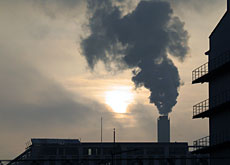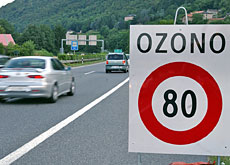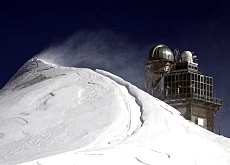Air pollution report takes breath away

Switzerland's air quality has improved considerably over the past 20 years but permitted levels of pollution are still often exceeded.
A governmental monitoring body said ozone, fine particles and nitrogen dioxide emitted by cars and trucks remained above limits last year.
The National Air Pollution Monitoring Network (Nabel) said on Friday that urgent action was required to significantly reduce emissions of nitrogen dioxide, volatile organic compounds (VOCs), respirable fine particles and carcinogenic diesel particles and ammonia.
High values of nitrogen dioxide were measured mostly along motorways near Switzerland’s biggest cities. There were 11 days in 2006 when concentrations were above 80 micrograms per cubic metre, nearly three times permitted levels (30ug/m3).
Urban areas were also affected by dangerous levels of fine particles. The average for 2006 was between 23 and 28ug/m3, even though Switzerland’s air pollution control policy sets the bar at 20ug/m3. And about every five or six days, concentrations were above 50ug/m3, going as high as 176ug/m3.
Ozone levels were comparable with averages of the past ten years. A recent study found that 80 per cent of the ozone affecting regions north of the Alps is blown in from abroad.
Nabel said however that the weather was partly responsible for the high concentrations of ozone as well as nitrogen dioxide fine particles.
At the beginning of the year, a long-lasting temperature inversion trapped harmful emissions, keeping them close to the ground.
On a positive note, amounts of sulphur dioxide, carbon monoxide, dust deposits and heavy metal were kept in check.
New measures needed
While presenting its report Nabel said “consistent and rigid” measures to control air pollution were “indispensable”.
At present, legislation includes technical regulations on emission reduction in industry, for motor vehicles and for machinery used in the construction sector, agriculture and forestry.
The government also uses economic instruments including taxes on VOCs, and a distance-dependent duty for trucks as well as tolls for commercial vehicles transiting Switzerland.
However, Nabel called for further economic incentives to encourage greater environmental responsibility.
Switzerland is also party to international agreements to reduce large-area, cross-border, air pollution from sulphur, nitrogen, heavy metals and persistent organic compounds.
Speed limits
A temporary move by some Swiss cantons in 2003 to reduce motorway speed limits to bring down high ozone levels was ineffective.
A study released earlier this year by the Paul Scherrer Institute found that the reduction in pollution that resulted from such limits was negligible.
The maximum speed limit was reduced from 120 km/h to 80km/h in August of 2003 during an unprecedented heatwave in Europe that led to 1,000 additional deaths in Switzerland.
swissinfo with agencies
Three million people in Switzerland – more than 40% of the population – live in regions that record above-average fine particle levels.
The Federal Environment Office says 21,000 tons of fine dust are emitted in Switzerland every year.
56% comes from the private and public use of mechanical abrasion.
The rest comes from diesel motors (17%), wood burning (15%), other burning (10%) and petrol, natural gas and natural oil (2%).

In compliance with the JTI standards
More: SWI swissinfo.ch certified by the Journalism Trust Initiative



You can find an overview of ongoing debates with our journalists here. Please join us!
If you want to start a conversation about a topic raised in this article or want to report factual errors, email us at english@swissinfo.ch.